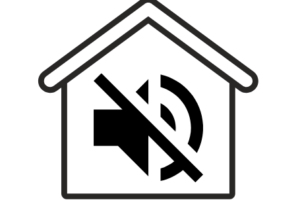If you’ve ever soundproofed ANYTHING, there’s no way you wouldn’t have heard of Green Glue, even if you haven’t tried it. It’s the most popular adhesive for soundproofing applications.
For people who don’t have a lot of soundproofing experience though, the question always remains- does Green Glue really work as a soundproofing solution?
The short answer is yes, Green Glue does work very well as a noise dampener- especially for low frequency sounds and is worth the cost. However, it’s important to remember that Green Glue is just one of the MANY important steps you need to take while soundproofing and if you don’t take care of those other aspects, you might be disappointed with the results.
We’ll look into those ‘other’ aspects in this post as well, but first- let’s set some expectations.
What Sort Of Results Can You Expect With Green Glue?
The results you get will vary according to your situation. Few things to determine beforehand are:
- What do you want to soundproof- walls, doors, ceiling, window, floor?
- Do you want to reduce impact noise, airborne noise OR both?
- Can you tear down the walls on both sides and build again or only on one side?
There isn’t an exact number to tell you how much decibel reduction you’ll get from using Green Glue in YOUR specific soundproofing scenario.
I can give you a rule of thumb though, and this is coming from the Green Glue website:
If you add a layer of drywall on one side with Green Glue- you’ll get about 12 dB noise reduction. This amounts to cutting out more than half( ~57%) of the noise.
Adding a layer of drywall on both sides along with Green Glue will give about 15 dB of noise reduction or about 64% perceived noise reduction– which won’t really be a noticeable difference over a single drywall layer and Green Glue.
Again, these results are meant to be a rule of thumb and in your specific case, it might actually make sense to go with a double drywall layer- you won’t know until you talk to a professional about this.
Soundproofing Ceilings: Does Green Glue Work For Impact and Airborne Noise Both?
Green Glue does reduce impact noise- which is basically the sound of footsteps, moving furniture, etc that one might hear from the floor upstairs- but whether the decrease is drastic enough to be noticeable depends on a few other factors.
Reducing airborne sounds is a bit easier. Simply adding a layer of drywall to the ceiling with Green Glue will noticeably reduce airborne noise from upstairs– such as talking, sounds from a TV, etc.
However, impact noises might just require some structural changes.
Specifically, there are 2 questions you should ask yourself here:
- Is the ceiling decoupled?- i.e: there shouldn’t be any mechanical connection between two layers of drywall.
- Is the air cavity inside the ceiling insulated?
For the best results, you’ll need to decouple the ceiling- such as by using staggered studs- and insulate the air cavity with some heavy material that adds mass- such as Mass Loaded Vinyl.
To this end, Green Glue actually recommends you use the Green Glue noiseproofing clips to decouple two sides of a wall.
How Does Green Glue Work?
Simply put, Green Glue is a damping compound that helps stop sound vibrations travelling between two rigid layers of wall.
Sound travels through any given medium by vibrating it’s molecules, which transmit sound.
Some mediums are more conducive to sound transmission than others- and in order to soundproof ANYTHING, all we’ve got to do is mimic the properties of those materials that do not allow sound to pass easily.
Basically, it all comes back to stopping sound vibrations. There are many ways of doing this- such as:
- Adding a damping layer- Green Glue
- Adding mass
- Decoupling walls such that they aren’t in direct contact and do not transmit sound easily
Now, as to how Green Glue stops sound:
When sound transmits through a wall, it affects the wall in such a way that its molecules vibrate perpendicular to it’s original position.
Like the upward- downward motion of a spring after it’s been pressed.
This up-down force or ‘shear’ force as it is technically called, excites other molecules to vibrate in a similar fashion. This creates a ripple effect which transmits sound energy through vibrations.
Green glue stops this upward-downward motion by resisting the shear force and not allowing the material, on which it is applied- to vibrate. This is what stops sound from getting transmitted.
The act of resisting the shear force creates heat at a microscopic level which gets dissipated inside the wall- in line with an important principle of thermodynamics:
“Energy can only change forms, not be created or destroyed”
That’s right folks, I remember SOME stuff from my high school physics textbook.
How To Apply Green Glue
Firstly, let me clear up a BIG misconception:
Green Glue isn’t ACTUALLY a glue. It’s just a damping compound for blocking sound.
That means it won’t hold up two layers of drywall together- you will still have to use the appropriate screws to secure the drywall.
In fact, it’s recommended that you apply the screws and attach the drywall within 10-15 mins of applying Green Glue.
If you’re using drywall, should ideally use ⅝” drywall as it’s thicker, has more mass and gives better soundproofing benefits.
There isn’t any specific pattern you need to follow while applying Green Glue. You can apply it any which way you like- just remember to use about 2 tubes per 4’ x 8’ sheet of drywall or whatever other material you’re putting it on.
That comes out to a dozen tubes of Green Glue for soundproofing 192 square feet or a single tube per 16 square feet.
Using the above figures, you can easily estimate the amount of Green Glue you’ll you need.
You also need to caulk the seams around each panel of drywall/other material that you apply.
It basically ensures there aren’t any air gaps from which sound can travel and also bonds the drywall onto the layer it is being applied. Sashco one is the most popular caulking products on Amazon.
In the same vein of ensuring there aren’t any air gaps in your walls- you should also install acoustic putty around the electrical outlets.
One last tip:
You might have some issues cleaning up after working with Green Glue.
It’s best to lay out a few layers of newspapers or cloth on the floor so that any Green Glue that overflows or gets dropped accidentally doesn’t end up ruining the flooring.
If it does get onto your clothes or any other surface and you need to clean it off, use some soap and water while it’s still wet. It gets really tough to remove it once it’s dried out.
And if you need still something stronger, try cleaning it with Isopropyl alcohol or stain removal product like Goo Gone.
Don’t worry if you do get it on you though- Green Glue isn’t toxic.
How Long Does Green Glue Take To Work?
Green Glue needs about 30 days to set properly- in order to give optimal benefits. It never really dries 100% and still remains a bit fluid- which is how it needs to be in order to work.
The number of days depend on the climate you’re in as well- if it’s cold and damp, it would obviously take longer to set, sometimes even upto 90 days.
How Long Can You Store Green Glue Without Using It?
Green Glue officially maintains that the expiry date is a year from manufacture. However, there are a lot of people who’ve shared their experiences online and say that if you store it in a cool place, away from direct sunlight or heat, it can last for 5-6 years before going bad!
The best way of knowing whether the glue is okay is to see it’s consistency. If it’s clumpy, then that means it’s gone bad- but if the consistency is free-flowing and clear, then it’s good to use.
Any Alternatives To Green Glue?
There’s only one that I could find online and it’s called QuietGlue.
Let’s talk about why you might choose Quietglue over Green Glue:
- Cheaper product- roughly half the price of Green Glue
- No odor- Green Glue is known to have a pungent smell- like the smell of paint
- Contains zero VOC’s(Volatile Organic Compounds)- one of the biggest sources of indoor air pollution
On the flip side, it’s also got some disadvantages:
- Overall, Quiet Glue doesn’t perform as well as Green Glue when it comes to soundproofing efficiency
- Takes longer to set than Green Glue
- Harder to use for beginners as it takes longer to set and hence, tends to ooze and drip down towards the floor, from behind the wall panels.
Conclusion
There’s little doubt that Green Glue is the best noise dampening solution in the market today.
However, it isn’t a magic pill- it’s an important step that you need to take for soundproofing but it’s definitely not the ONLY step.
Cost wise, I’d recommend you figure out just how much Green Glue you’ll need for your project and buy it all at once. Remember- a dozen tubes will be good for 192 sq. feet.
In fact, if you buy a 5 gallon bucket instead of individual tubes, you’ll save about 25% of the cost.
You’ll also need a pail applicator along with it- which holds approximately one tube worth of glue, so you can ensure you’re using the right amount of glue per sheet.
Hope this post helped you, and if there’s anything I missed out- comment below and let me know!


